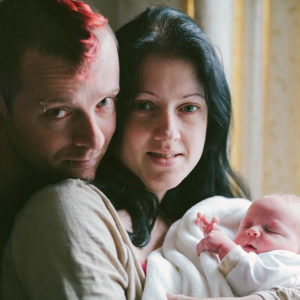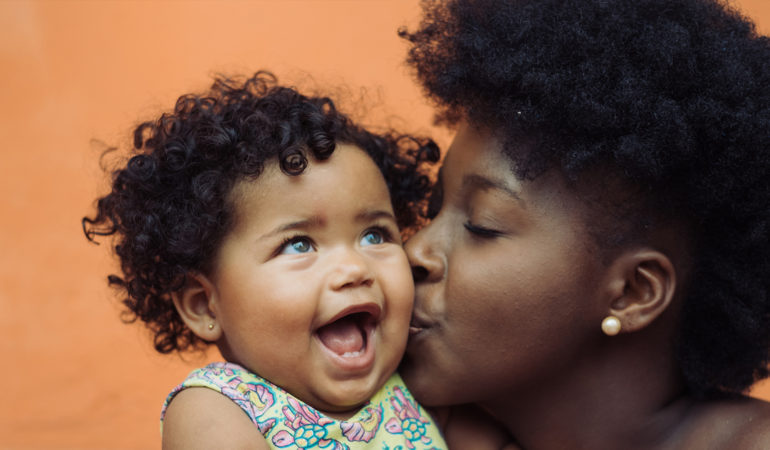Based on: Evidence base review of couple- and family-based psychosocial interventions to promote infant and early childhood mental health (2010-2019). Jennifer W. Kaminski, PhD, Lara R. Robinson, MPH, Helena J. Hutchins, MPH, Kimberly B. Newsome, MPH, and Caroline M. Barry, MPH | January 2022 Journal of Marital and Family Therapy
Most mental and behavioral problems have roots in childhood (Caspi, Moffitt, Newman, & Silva 1996; National Academies of Sciences, Engineering, and Medicine [NASEM], 2019). Positive mental health in infants and young children is tied to nurturing and responsive early relationships (Lyons-Ruth et al., 2017; Robinson et al., 2017), and these early relationships lay the foundation for lifelong physical and mental health (NASEM, 2016; NASEM, 2019). Our evidence review was inspired by these fundamentals, along with the knowledge that interventions in a child’s first five years are critical in supporting later health and success.
As public health researchers, we think about the population-level burden of infant and early childhood mental health problems and the potential of evidence-based prevention and treatment interventions that can support early relationships to foster lifelong health and wellbeing. We conducted this systematic review to provide information not only for individual couple- and family-based psychosocial intervention providers, but also for decision-makers at the local, state, and federal level to have the evidence they need to inform systemic healthcare decisions. While other systematic reviews have summarized the evidence for the impact of family-based interventions in different populations and ages of children (Estrada & Pinsof, 1995, Kaminski & Claussen, 2017; Kaslow, Broth, Smith, & Collins, 2012; Northey, Wells, Silverman, & Bailey, 2003), our paper is the first application of Southam-Gerow and Prinstein’s (2014) Evidence Base Update criteria to couple- and family-based psychosocial interventions to promote infant and early childhood mental health.
How did we summarize the evidence? We conducted this systematic review using search terms related to couple or family-based interventions (e.g., couple therapy) and infant and early childhood mental health (e.g., attachment) in peer-reviewed publications. Our broad search terms identified more than 40,000 potentially relevant titles. After looking carefully at these titles and abstracts, we identified 695 articles that merited retrieval for further review. Next, we completed a full-text review of the 695 articles to identify the studies that tested interventions fitting our inclusion criteria:
- The intervention began prior to or at child age 3 years, and the outcomes were measured prior to age 5 years.
- Participants were either married or cohabitating couples, parent-child dyads, families (e.g., parent-parent-child triads), or parents.
- The intervention focused on changing the knowledge, attitudes, emotions, behaviors, and/or relationships among participants.
- The study reported on emotional, behavioral, functional, or relational outcomes in infants and young children.
Studies were excluded if the interventions focused only on populations with identified issues such as children who have experienced maltreatment or other trauma, and children with developmental disabilities. Populations and corresponding interventions for those issues are worthy of a separate review beyond the scope of our current effort.
 After carefully reading all 695 articles, we identified 39 studies published between 2010 and 2019 (the requested date range for this review) that met all of these criteria. When classifying the level of evidence, we also included any eligible study published between 2000 and 2009 that would change the classification. For the included studies, we then carefully summarized two important areas for each study: 1) the design of the study, including whether participants were randomly assigned to intervention and control groups; and 2) whether the families who received the intervention evidenced improvement in infant and early childhood mental health outcomes compared to families who did not.
After carefully reading all 695 articles, we identified 39 studies published between 2010 and 2019 (the requested date range for this review) that met all of these criteria. When classifying the level of evidence, we also included any eligible study published between 2000 and 2009 that would change the classification. For the included studies, we then carefully summarized two important areas for each study: 1) the design of the study, including whether participants were randomly assigned to intervention and control groups; and 2) whether the families who received the intervention evidenced improvement in infant and early childhood mental health outcomes compared to families who did not.
Finally, we grouped the interventions into categories of similar approaches, instead of presenting results for each individual study or specific packaged program. We determined the intervention approaches could be sorted into 11 categories that facilitate the use of the results in clinical and public health decision-making, based on the intervention’s theoretical underpinnings, population served, and standardization. As you can see from the approaches listed here, some of the approaches were broad and some specific:
Infant and Early Childhood Mental Health Treatments
- Parent-focused Psychotherapy
- Parent-Infant Psychotherapy
Focused Preventive Interventions
- Couple Interventions to Support the Transition to Parenthood
- Interventions to Support Adolescent Mothers
- Interventions to Support Breastfeeding by Improving Mother-Infant Interactions
- Interventions to Enhance Parent-Infant Relationships
- Interventions to Promote Positive Parenting through Shared Reading and Play
- Behavioral Interventions to Support Parents of Toddlers
Broader-Scope Preventive Interventions
- Curriculum-Based Interventions for At-Risk Parents and Families
- Tiered Interventions to Provide Support Based on Assessed Risk
- Home Visiting Interventions to Provide Individualized Support to Families at Risk
What did the evidence show?
We applied the Evidence Base Update criteria to classify the 11 different intervention approaches (using data from 39 individual studies) into five rankings: Well-established, Probably Efficacious, Possibly Efficacious, Experimental, or Unclassifiable (meaning insufficient evidence in this time period to classify under these criteria).
No intervention approaches in our review of this time period met criteria to be considered Well-Established, which requires at least two independent randomized trials showing treatment superiority.
Four intervention approaches were classified as Probably Efficacious, the criteria for which is met when an intervention has been shown to be superior to a no-treatment control group in at least two randomized-controlled studies, or when it has been shown to be superior to another intervention or equivalent to a well-established intervention in one study or in multiple randomized-controlled studies:
- Interventions to Support Adolescent Mothers
- Behavioral Interventions to Support Parents of Toddlers
- Tiered Interventions to Provide Support Based on Assessed Risk
- Home Visiting Interventions to Provide Individualized Support to Parents
Intervention approaches with at least one randomized-controlled study showing superiority over a wait-list/no-treatment control group, or two or more non-randomized but otherwise methodologically strong studies were deemed Possibly Efficacious. Two intervention categories, Couple Interventions to Support the Transition to Parenthood and Parent-Infant Psychotherapy met these criteria.
The Experimental classification included some studies with rigorous design but not enough evidence of improvement in outcomes. Three intervention groups met this criterion: Parent-focused Psychotherapy, Interventions to Enhance Parent-Infant Relationships, and Interventions to Support Breastfeeding by Improving Mother-Infant Interactions.
Two intervention approaches (Interventions to Promote Positive Parenting through Shared Reading and Play and Curriculum-based Interventions for At-risk Parents and Families) have yet to document evidence of superiority versus a comparison group on infant and early childhood mental health outcomes in either randomized or non-randomized studies during the period of this review. These approaches have also not shown inferiority to a comparison group; therefore, they do not yet have classifiable evidence under these criteria.
What is the importance of these findings?
In this review, we followed the current convention of classifying general categories of intervention approaches, rather than evaluating specific brand-name packaged programs, to inform family, provider, community, and health plan decision-making. The Evidence Base Update criteria were designed to identify the psychological treatments with the most promise to reduce the youth mental health burden (Southam-Gerow & Prinstein, 2014). The highest level of evidence documented here was the Probably Efficacious classification, suggesting that the four intervention approaches meeting this classification have the greatest potential for impact on infant and early childhood mental health.
What are the next steps?
Clinicians and public health practitioners can work to increase the reach of couple and parent-based psychosocial interventions that demonstrate evidence of positive infant and childhood mental health outcomes, such as those in the Probably Efficacious grouping. As public health researchers, we continue to gather and summarize evidence on approaches to best support infant and early childhood mental health. In addition, we recognize that couple- and family-based psychosocial interventions may not be sufficient alone to support population-level infant and childhood mental health. As we navigate through a national emergency of children’s mental health that disproportionately affects black, indigenous, and people of color (American Academy of Pediatrics, 2021), a broader public health approach has been recommended for children’s mental health (Hoagwood & Kelleher, 2020). This approach could include additional attention to (1) making services available in locations convenient to the family; (2) examining alternatives to our current healthcare payment system approaches to children’s mental health; and (3) promoting equity by meeting parents’ basic mental health and economic security needs.
Note: The findings and conclusions are those of the authors, and may not represent the official position of the Centers for Disease Control and Prevention.
This article is offered free by AAMFT. If you are interested in accessing members-only content, join today!
The highest level of evidence documented here was the Probably Efficacious classification, suggesting that the four intervention approaches meeting this classification have the greatest potential for impact on infant and early childhood mental health.
 Kimberly Newsome, MPH, is with the National Center on Birth Defects and Developmental Disabilities, Centers for Disease Control & Prevention, Atlanta, GA.
Kimberly Newsome, MPH, is with the National Center on Birth Defects and Developmental Disabilities, Centers for Disease Control & Prevention, Atlanta, GA.
 Jennifer W. Kaminski, PhD, is with the National Center on Birth Defects and Developmental Disabilities, Centers for Disease Control & Prevention, Atlanta, GA.
Jennifer W. Kaminski, PhD, is with the National Center on Birth Defects and Developmental Disabilities, Centers for Disease Control & Prevention, Atlanta, GA.
 Lara R. Robinson, PhD, MPH, is with the National Center on Birth Defects and Developmental Disabilities, Centers for Disease Control & Prevention, Atlanta, GA.
Lara R. Robinson, PhD, MPH, is with the National Center on Birth Defects and Developmental Disabilities, Centers for Disease Control & Prevention, Atlanta, GA.
 Caroline Barry, MPH, is with Emory University, Atlanta, GA.
Caroline Barry, MPH, is with Emory University, Atlanta, GA.
 Helena Hutchins, MPH, is with the National Center on Birth Defects and Developmental Disabilities, Centers for Disease Control & Prevention, Atlanta, GA, and the Oak Ridge Institute for Science and Education, Centers for Disease Control and Prevention Research Participation Programs, Oak Ridge, TN..
Helena Hutchins, MPH, is with the National Center on Birth Defects and Developmental Disabilities, Centers for Disease Control & Prevention, Atlanta, GA, and the Oak Ridge Institute for Science and Education, Centers for Disease Control and Prevention Research Participation Programs, Oak Ridge, TN..
REFERENCES
American Academy of Pediatrics. (2021). AAP-AACAP-CHA declaration of a national emergency in child and adolescent mental health. Retrieved from https://www.aap.org/en/advocacy/child-and-adolescent-healthy-mental-development/aap-aacap-cha-declaration-of-a-national-emergency-in-child-and-adolescent-mental-health
Caspi, A., Moffitt, T. E., Newman, D. L., & Silva, P. A. (1996). Behavioral observations at age 3 years predict adult psychiatric disorders: Longitudinal evidence from a birth cohort. Archives of General Psychiatry, 53(11), 1033-1039. https://doi.org/10.1001/archpsyc.1996.01830110071009
Estrada, A. U. & Pinsof, W. M. (1995). The effectiveness of family therapies for selected behavioral disorders of childhood. Journal of Marital and Family Therapy, 21, 403-440.
Hoagwood, K. E., Kelleher, K. J., (2020). A Marshall Plan for children’s mental health after COVID-19. Psychiatric Services, 71, 1216-1217. https://doi.org/10.1176/appi.ps.202000258
Kaminski, J. W., & Claussen, A. H. (2017). Evidence base update for psychosocial treatment of disruptive behaviors in children. Journal of Clinical Child and Adolescent Psychology, 46, 477-499. http://dx.doi.org/10.1080/15374416.2017.1310044
Kaslow, N. J., Broth, M. R., Smith, C. O., & Collins, M. H. (2012). Family-based interventions for child and adolescent disorders. Journal of Marital and Family Therapy, 38, 82-100. https://doi.org/1 0.1111/j.1 752-0606.2011.00257.x
Lyons-Ruth, K., Todd Manly, J., Von Klitzing, K., Tamminen, T., Emde, R., Fitzgerald, H., Paul, C., Keren, M., Berg, A., Foley, M., & Watanabe, H. (2017). The worldwide burden of infant mental and emotional disorder: Report of the Task Force of the World Association for Infant Mental Health. Infant Mental Health Journal, 38(6), 695-705. https://doi.org/10.1002/imhj.21674
National Academies of Sciences, Engineering, and Medicine. (2016). Parenting matters: Supporting parents of children ages 0-8. Washington, DC: The National Academies Press. https://doi.org/ 10.17226/21868
National Academies of Sciences, Engineering, and Medicine. (2019). Fostering healthy mental, emotional, and behavioral development in children and youth: A national agenda. Washington, DC: The National Academies Press. https://doi.org/10.17226/25201
Northey, W. F., Jr., Wells, K. C., Silverman, W. K., & Bailey, C. E. (2003). Childhood behavioral and emotional disorders. Journal of Marital and Family Therapy, 29(4), 523-545. https://doi.org /10.1111/j.1752-0606.2003.tb01693.x
Robinson, L. R., Bitsko, R. H., Thompson, R. A. (2017). CDC grand rounds: Addressing health disparities in early childhood. MMWR Morbidity & Mortality Weekly Report, 66, 769-772. http://dx.doi.org/10.15585/mmwr.mm6629a1external icon
Southam-Gerow, M. A., & Prinstein, M. J. (2014). Evidence base updates: The evolution of the evaluation of psychological treatments for children and adolescents. Journal of Clinical Child and Adolescent Psychology, 43(1), 1-6. https://doi.org/10.1080/15374416.2013.855128
Other articles
Evidence Base Update on the Efficacy and Effectiveness of Couple and Family Interventions, 2010-2019
Since 1995, the Journal of Marital and Family Therapy (JMFT) has published decade reviews to provide clinicians and other stakeholders an update on the evidence base for couple and family interventions for mental and behavioral disorders and health conditions. The most recent decade review was published in January 2022. This exciting issue reviewed the empirical evidence published from 2010 to 2019 on couple and family interventions for a range of mental and behavioral disorders and health conditions relevant to our work as couple and family therapists. Some of those reviews are highlighted in this special issue of the magazine.
Andrea K. Wittenborn, PhD and Kendal Holtrop, PhD
Evidence in Support of Couple and Family Interventions for Depressive and Bipolar Disorders: What Does the Research Say?
Among those who experience depressive or bipolar disorders, too few get the treatment they need to experience relief. When people do seek treatment, it’s commonly in the form of medication, individual therapy, or both. Given the impact of close relationships on the course of depressive and bipolar disorders, targeting clients’ relationships may be a key mechanism to promoting symptom improvement.
Sarah B. Woods, PhD
Couple and Family Interventions for High Mortality Health Conditions
The authors discuss their findings as MedFTs who see health, wellness, illness, trauma, and death in the context of families as they interface with larger systems such as healthcare, schools, and military systems.
An interview with Angela Lamson, PhD, Jennifer Hodgson, PhD, Keeley Pratt, PhD, Tai Mendenhall, PhD, Alison Wong, PhD, Erin Sesemann, PhD, Braden Brown, PhD, Erika Taylor, MS, Jacqueline Williams-Reade, PhD, Daniel Blocker, PhD, Jennifer Caspari, PhD, Max Zubatsky, PhD, and Matthew Martin, PhD




